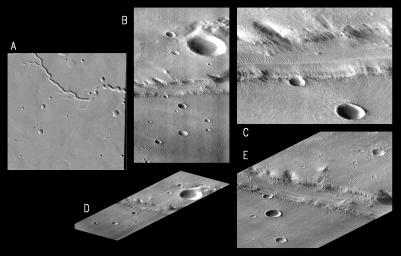
|
MGS Views of Nirgal Vallis
- Click the image above for a larger view
- Full-Res JPEG (2637 x 1686) (722.7 kB)
- Full-Res TIFF (2637 x 1686) (2.6 MB)
Caption:
At 3:08:30 AM on September 21, 1997, the MOC field of view swept across the highland valley network Nirgal Vallis at 28.5°S, 41.6 W. Although the MGS spacecraft was at an altitude of about 400 km (250 miles), the MOC was pointed obliquely across the planet at about 35°, so the distance to Nirgal Vallis was closer to 800 km (500 miles). At that range and viewing angle, the MOC field of view was about 16 km (10 miles) wide, and the resolution was about 9 meters (30 feet) per pixel. The acquired image is 36 km (23 miles) long.
Five images are shown above:
(A) is an excerpt from the USGS MDIM, roughly 180 km (112 mile) square. The small box outlines the MOC image acquisition.(B) is MOC frame P006_05, shown here at reduced resolution because the full image is almost 7 MBytes in size. Because the MOC acquires its images one line at a time, the cant angle towards the sun-lit portion of the planet, the spacecraft orbital velocity, and the spacecraft rotational velocity combined to significantly distort the image. However, even in this reduced resolution version, dunes can be seen in the canyon and in areas on the upland surface around the canyon.
(C) shows a portion of P006_05 at the full resolution of the data. This view shows the dunes more clearly, and also illustrates better the distortion introduced by the method of data acquisition.
(D) shows P006_05 skewed and rotated to the perspective that MOC was viewing at the time the image was taken.
(E) shows a full-resolution version of a portion of the rotated perspective view.
Nirgal Vallis is one of a number of canyons called valley networks or runoff channels. Much of the debate concerning the origin of these valleys centers on whether they were formed by water flowing across the surface, or by collapse and upslope erosion associated with groundwater processes. At the resolution of this image, it is just barely possible to discern an interwoven pattern of lines on the highland surrounding the valley, but it is not possible to tell whether this is a pattern of surficial debris (sand or dust), as might be expected with the amount of crater burial seen, or a pattern of drainage channels. With 4X better resolution from its mapping orbit, MOC should easily be able to tell the difference between these two possibilities.
Background Info:
Launched on November 7, 1996, Mars Global Surveyor entered Mars orbit on Thursday, September 11, 1997. The spacecraft has been using atmospheric drag to reduce the size of its orbit for the past three weeks, and will achieve a circular orbit only 400 km (248 mi) above the surface early next year. Mapping operations begin in March 1998. At that time, MOC narrow angle images will be 5-10 times higher resolution than these pictures.
Malin Space Science Systems and the California Institute of Technology built the MOC using spare hardware from the Mars Observer mission. MSSS operates the camera from its facilities in San Diego, CA. The Jet Propulsion Laboratory's Mars Surveyor Operations Project operates the Mars Global Surveyor spacecraft with its industrial partner, Lockheed Martin Astronautics, from facilities in Pasadena, CA and Denver, CO.
Cataloging Keywords:
| Name | Value | Additional Values |
|---|---|---|
| Target | Mars | |
| System | ||
| Target Type | Planet | |
| Mission | Mars Global Surveyor (MGS) | |
| Instrument Host | Mars Global Surveyor | |
| Host Type | Orbiter | |
| Instrument | Mars Orbiter Camera (MOC) | |
| Detector | ||
| Extra Keywords | Atmosphere, Crater, Dune, Dust, Grayscale, Rotation, Water | |
| Acquisition Date | ||
| Release Date | 1997-10-02 | |
| Date in Caption | 1997-09-21 | |
| Image Credit | NASA/JPL/Malin Space Science Systems | |
| Source | photojournal.jpl.nasa.gov/catalog/PIA00942 | |
| Identifier | PIA00942 | |
